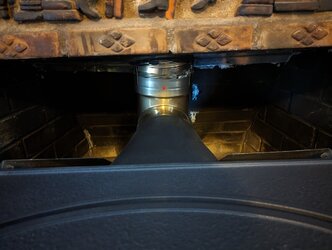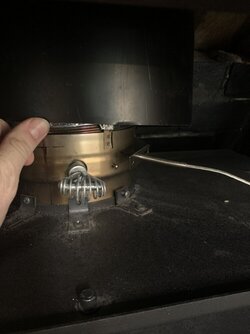Hi all. Preparing for the second season with the Jotul F500 V3. The stove was installed with single-wall flex liner upon the recommendation of the installer and the dealer I bought the stove from running up ~27 feet of masonry chimney. New this year is a block off plate that I installed because I found out too late that my installer was a lazy bum and wouldn't install one, instead just stuffing insulation in the void.
Anyway... I'd like to run a flue thermometer of some sort, but have challenges... since the flue is single wall stainless flex liner, magnetic surface thermometers won't stick to it, and the probes all seem designed for use with double-wall. Now, the stove is set up for rear-exit into a tee. I'm wondering if I can install a probe type thermometer into the upper collar of the tee though the flex liner. Would that be "close enough" to double-wall for the probe to function properly? Here is a pic with red dot indicating possible installation location:
Thanks for any suggestions or feedback.

Anyway... I'd like to run a flue thermometer of some sort, but have challenges... since the flue is single wall stainless flex liner, magnetic surface thermometers won't stick to it, and the probes all seem designed for use with double-wall. Now, the stove is set up for rear-exit into a tee. I'm wondering if I can install a probe type thermometer into the upper collar of the tee though the flex liner. Would that be "close enough" to double-wall for the probe to function properly? Here is a pic with red dot indicating possible installation location:
Thanks for any suggestions or feedback.



